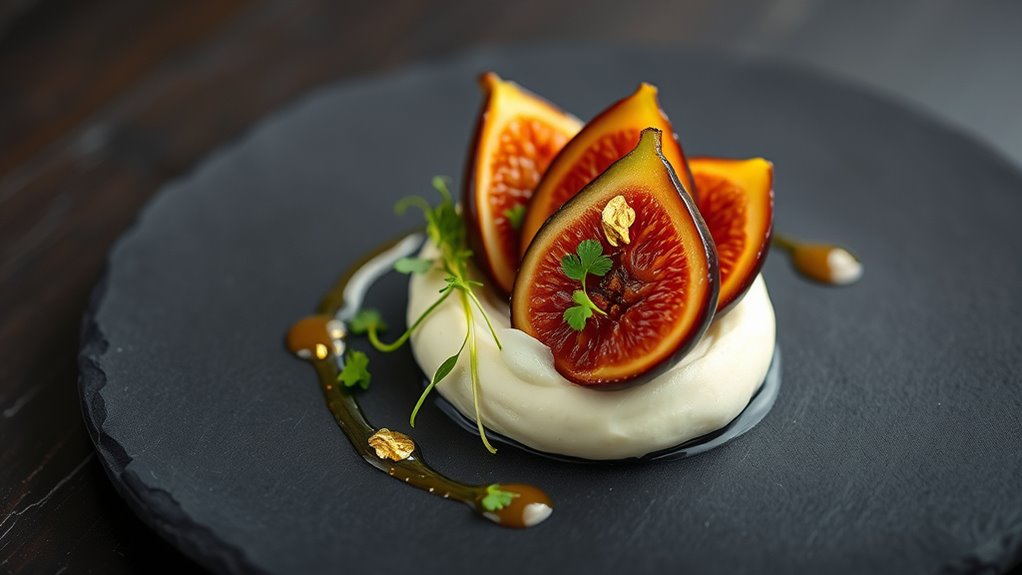#FoodPorn has transformed restaurant plating by making visual appeal the main focus. You now see dishes designed with shareability and social media impact in mind. Chefs use creative techniques like layering, contrasting colors, and negative space to craft stunning plates that attract likes and shares. This shift pushes restaurants to prioritize aesthetics, turning food into visual art. Want to discover more about how this trend continues to shape cuisine today? Keep exploring.
Key Takeaways
- Food porn shifted focus from traditional taste to highly aesthetic, visually captivating plating techniques to attract social media attention.
- Chefs now prioritize innovative, artistic presentations that enhance shareability, incorporating layering, contrasting colors, and decorative garnishes.
- Plating evolved into a visual language, using negative space and curated elements to create sleek, camera-friendly dishes.
- Restaurants design dishes with social media in mind, emphasizing bold colors and minimalism to evoke desire and curiosity online.
- The trend blurs culinary artistry with visual storytelling, making presentation a key component of overall dining experience and marketing.

In recent years, food porn has taken on a new level of importance, especially with the rise of social media platforms where stunning restaurant plating can turn a simple dish into a visual masterpiece. You’ve probably noticed how some photos of food get hundreds of likes, shares, and comments—proof that presentation matters. This shift has pushed chefs and restaurants to rethink how they plate their dishes, aiming not just for taste but also for those perfect, share-worthy visuals. Your Instagram feed is flooded with images that showcase vibrant colors, artistic arrangements, and meticulous details—all designed to catch the eye at first glance. That’s no accident; it’s a direct result of the obsession with creating Instagram aesthetics that stand out in a crowded digital space.
Food presentation now emphasizes visual appeal to stand out on social media and attract diners.
To achieve these eye-catching visuals, many chefs now rely on innovative plating techniques. These methods aren’t just about making food look pretty; they’re about storytelling through presentation. For example, layering ingredients thoughtfully, using height to add dimension, or employing contrasting colors can turn an ordinary meal into a work of art. You’ll see dishes with carefully placed garnishes, drizzles, or edible flowers that elevate the overall look. Plating techniques like negative space—leaving areas of the plate intentionally empty—draw focus to the main elements and create a sleek, sophisticated vibe. These techniques help in crafting a cohesive visual narrative that invites viewers to almost taste the dish through their screens.
This emphasis on Instagram aesthetics has transformed how restaurants approach plating. Instead of just serving food for immediate consumption, chefs now consider how each dish will photograph. The goal is to produce images that evoke desire and curiosity, encouraging followers to visit in person or order that dish. This means paying attention to every detail—from the placement of each ingredient to the choice of plates and backgrounds. Sharp contrasts, minimalism, or bold colors are often used deliberately to make food pop in photos. As a result, plating techniques have evolved into a kind of visual language, where every element is carefully curated to maximize aesthetic appeal.
Ultimately, food porn has shifted the focus from purely culinary skills to a blend of artistry and visual storytelling. You don’t just want food that tastes good—you want it to look irresistible in photos. This new era of restaurant plating demands creativity, precision, and an understanding of what makes an image shareable. If you’re a foodie or a chef, embracing these trends can help elevate your presentation game and ensure your dishes shine both on the plate and on your social media feed.
Frequently Asked Questions
How Has Social Media Influenced Professional Plating Standards?
Social media, especially Instagram aesthetics, has transformed professional plating standards by emphasizing eye-catching presentation. You now focus on visual storytelling, making dishes more photogenic to attract likes and shares. This shift encourages chefs to craft plates that are not only delicious but also visually stunning. As a result, plating becomes an art form designed for social media, elevating the overall dining experience and setting new industry benchmarks.
Do Chefs Intentionally Design Dishes for Visual Appeal or Taste?
You might think chefs choose between taste and visual appeal, but in reality, they master the art of plating artistry to create dishes that dazzle the eyes and delight the palate. They intentionally design for visual deception, making food look like a masterpiece. It’s an incredible balance, where every detail is crafted to wow you at first glance, proving that stunning presentation can elevate the entire dining experience.
Has Food Photography Affected Customer Expectations at Restaurants?
Food photography has markedly impacted your expectations at restaurants by highlighting presentation aesthetics. When you see stunning images online, you start to expect similar visual appeal in real dishes, influencing your perceptions. This shift encourages restaurants to prioritize beautiful plating, knowing it shapes your dining experience. As a result, your overall satisfaction depends more on presentation aesthetics, making visual appeal a key factor in your restaurant choices and perceptions of quality.
Are There Health Concerns Related to Overly Elaborate Plating?
Imagine a carefully curated masterpiece, but beneath the art, health risks lurk. Overly elaborate plating can sometimes hide nutritional impact, making it hard to gauge ingredients and portion sizes. You might unknowingly consume excess fats, sugars, or sodium, increasing health risks. While stunning visuals tempt your eyes, remember that intricate designs may compromise clarity about what you’re eating, potentially affecting your overall well-being.
How Do Cultural Differences Shape Food Presentation Trends?
Cultural differences deeply influence food presentation trends, shaping how chefs balance fusion cuisine with traditional aesthetics. You’ll notice that some cultures emphasize vibrant colors and intricate designs, blending elements from various cuisines, while others prioritize simplicity and tradition. This diversity encourages creativity in plating, allowing you to appreciate unique artistic expressions rooted in cultural heritage. Embracing these differences helps you experience a richer, more authentic dining experience that celebrates global culinary diversity.
Conclusion
You see, when you pay attention to how food looks, you’re not just eating—you’re experiencing art. Take a restaurant that redesigned its plating to match Instagram trends; they saw a 20% boost in reservations. Food porn isn’t just about sharing pretty pictures; it changes expectations and raises the bar for every dish. So next time you dine, consider how presentation influences your whole experience—because in today’s culinary world, visuals truly can make or break your meal.










